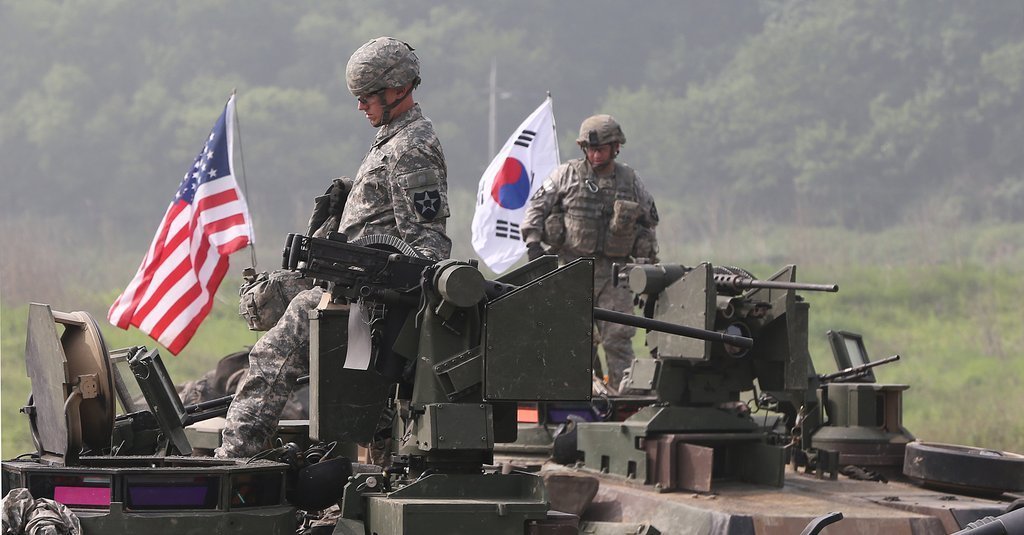Defense cost-sharing sheds light on seven decades of Korea-US alliance
By Ahn Sung-miPublished : March 10, 2021 - 16:01

With South Korea and the US clinching a new accord on how to share the cost of maintaining the US troops stationed on the Korean Peninsula, the deal has drawn attention to how this arrangement was first forged and how it has transformed over the decades.
From the US forces landing in the southern half of the peninsula after World War II to the US-led allies helping South Korea repel an invasion by the communist North and the troops’ presence hereafter, the US military has been a key part of the South’s defense and its deterrence against evolving threats from the North.
Here’s a brief overview of how US Forces Korea came into being. It explains the cost-sharing framework and the negotiations, and the overall bilateral security alliance that was born from the ashes of the 1950-53 Korean War.
A security alliance born of war
Shortly after the Korean War ended in an armistice, South Korea and the US signed a mutual defense treaty in October 1953, formalizing their security alliance. The two countries committed to defend each other in the event of an attack as part of the deal, and also established legal grounds for the US to station troops here.
In 1957 US Forces Korea was formally launched, establishing its headquarters in Yongsan, central Seoul. The number of troops has fluctuated over the decades, depending on Washington’s overseas deployment strategy and regional security circumstances. Today there are about 28,500 American soldiers, sailors, airmen and Marines across the bases here, in what is Washington’s third-largest military presence overseas after Japan and Germany.
The deployment benefited both sides at the time. The US military provided war-torn South Korea with a much-needed security guarantee against possible aggression from its northern neighbor, while for Washington, its military presence served as the US’ bulwark against communist expansion in the region during the Cold War.
In 1966 the two countries entered into the Status of Forces Agreement, or SOFA, which governs the legal status of US troops stationed here.
The agreement stipulated that the US must bear all costs of maintaining the US forces, whereas South Korea only paid for the land and facilities used by the troops.
But starting in the 1970s, under the Nixon Doctrine, which called on the country’s Asian allies to tend to their own military defense, the US began drawing back troops from South Korea. It also stepped up demands on South Korea for greater military spending in the 1980s, as Washington was cutting its military budget on a rising trade deficit.
As the South Korean economy developed in the late 1980s, the pressure to bear more of the costs grew stronger. With fears of more US troop cuts that could threaten South Korea’s security, in 1991 Seoul agreed to shoulder part of the costs of stationing the American troops, forming a contract under SOFA known as the Special Measures Agreement.
Cost-sharing and tough negotiations
Since 1991, South Korea has shared the costs for the upkeep of the US forces, including wages for South Korean workers at the base, construction of military installations and logistical support. To determine the amount borne by each side, the two countries hold negotiations to renew the SMA every two to five years.
In its initial year, 1991, Seoul paid 107.3 billion won ($94.34 million). That amount gradually increased, and has risen more than tenfold in the last three decades.
But settling on the costs and terms has always been tough, with the talks at times becoming a source of contention between the two allies. Eleven SMA talks have been held since 1991, and over the years several deadlines were missed as the allies failed to agree on a price tag.
A major setback came during the Trump administration when the former president, under his “America First” slogan, insisted that the US’ allies were not paying enough for the US troops on their soil, accusing some of being “free riders.”
In 2018 the US asked South Korea for a hefty 50 percent hike from the previous accord. After an impasse, the two sides eventually settled on a 1.04 trillion won payment from South Korea in 2019, an 8.2 percent hike. Unlike the previous five-year pact, the agreement only covered one year.
In late 2019 the two countries began their 11th SMA talks with hopes of concluding them before the one-year contract expired. But with Trump doubling down -- at one point demanding more than a fivefold increase to $5 billion and threatening a pullout of troops -- the talks remained at a standstill and the 2019 deadline passed.
Last year the two sides were close to reaching a deal, but Trump rejected what Seoul called its “best offer” of a 13 percent hike from the 2019 accord. He is said to have requested $1.3 billion, a significant cutback from the previous $5 billion demand, but still a whopping 50 percent hike for Seoul.
Due to the stalemate, 4,000 South Korean employees of USFK were forced to go on unpaid leave for more than two months last April. Seoul decided to provide stopgap funding to pay their wages until the end of that year.
Since President Joe Biden’s term began in January, the stalled talks have picked up speed. Before the election, Biden pledged not to use the US troop presence to “extort” money from Seoul, and the two sides were keen on clinching a deal as soon as possible.
The latest defense cost-sharing agreement is seen as a sign of reinvigorated ties between the two countries, and also as part of Biden’s alliance-centric policy of improving relationships with traditional allies to tackle various challenges, including a nuclear-armed North Korea and the need to keep an assertive China in check.
The agreement now awaits several steps before it can be concluded, including a tentative signing, a review by the Ministry of Government Legislation, and approval by the Cabinet and then President Moon Jae-in before the two countries officially close the deal. Finally, the National Assembly here has to ratify the SMA as the last step, while the US does not require congressional approval.
By Ahn Sung-mi (sahn@heraldcorp.com)


















![[KH Explains] Hyundai's full hybrid edge to pay off amid slow transition to pure EVs](http://res.heraldm.com/phpwas/restmb_idxmake.php?idx=652&simg=/content/image/2024/04/18/20240418050645_0.jpg&u=20240418181020)

![[Today’s K-pop] Zico drops snippet of collaboration with Jennie](http://res.heraldm.com/phpwas/restmb_idxmake.php?idx=642&simg=/content/image/2024/04/18/20240418050702_0.jpg&u=)